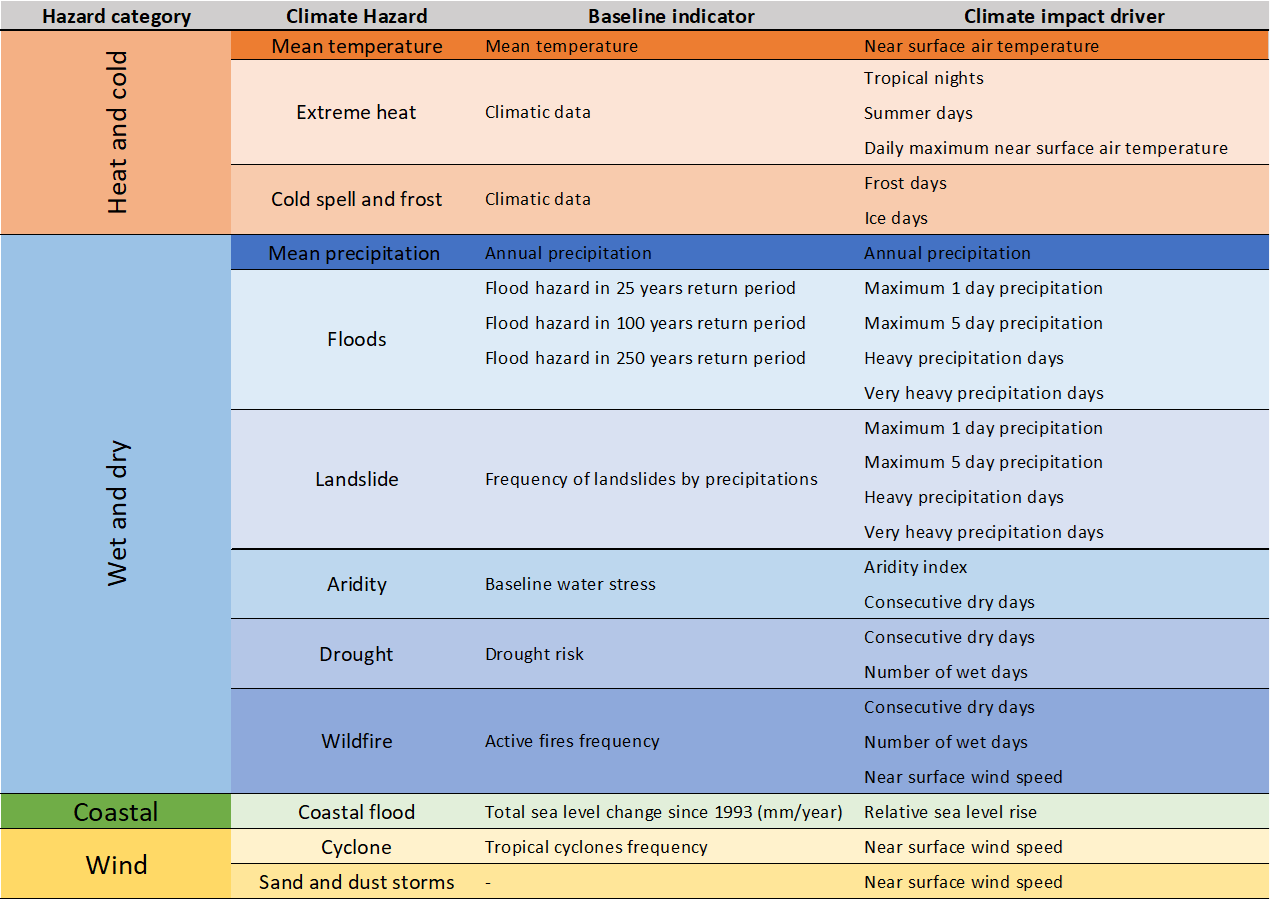The climate-related hazards analyzed in this study can be grouped in four hazard categories (Fig. 1): heat and cold, wet and dry, coastal, and wind-related.

Summary table of the hazard types and the baseline indicator and CID for each hazard.
In the following section, a description of the climate hazards is provided.
Mean temperature influences ecosystems and a wide range of human activities. The selected CID for this hazard is the near-surface air temperature.
Extreme heat is an important hazard for many sectors and activities, including human health, agriculture, construction, transport and energy. The selected CIDs focus on high temperature extreme conditions.
Cold spell and frost are relevant hazards for several sectors, including agriculture, construction and transport. Their relevance and impacts largely depend on the affected climate zones and system. The selected CIDs account for the frequency of hazardous conditions.
Mean precipitation influences ecosystems and a wide range of human activities. The total annual precipitation is the CID selected for this hazard.
Flooding analyzes pluvial and riverine flooding hazards. Extreme precipitation is an important hazard for many sectors, including hydrological applications, transport and disaster risk management. The selected CIDs indices account for the magnitude and frequency of extreme precipitation.
Landslide is a complex hazard linked to slope failures that cannot be resolved by climate models. Only landslides directly related to precipitation can be estimated. The selected CIDs are, thus, those of the flooding hazard.
Aridity changes represent an important hazard influencing several sectors, including water management, agriculture and energy. Aridity is a natural permanent imbalance in the water availability consisting of low average annual precipitation, with high spatial and temporal variability, resulting in overall low moisture and low carrying capacity of the ecosystems. The selected CIDs indices are based on precipitation and evapotranspiration.
Drought is an important climate-related hazard affecting agriculture, forestry, energy, manufacturing, and water management sectors. Drought is a period of abnormally dry weather that cause a serious hydrological imbalance. Drought differs from aridity in that drought is temporary and it occurs in virtually all climatic regimes. Meteorological drought is analysed through CIDs based on the (absence) of precipitation.
Wildfire is an important hazard for forestry, agriculture, human health and settlements. It can lead to environmental and economic damage, and often results in the loss of human lives. The estimation of future wildfires through climate models is highly complex. The selected CIDs are based on fuel aridity (the drying out of forests and other burnable ecosystems) and the spread of the fires.
Coastal flood is an important hazard in coastal regions, where they can affect buildings, infrastructure, energy and water supply. The selected CID is sea level change relative to land, which is most relevant for coastal adaptation purposes.
Wind-related hazards such as tropical cyclones or sand and dust storms are an important hazard for a wide range of sectors and activities such as human health, forestry, infrastructure, buildings, energy and transport. However, data availability for this hazard is limited, and there are substantial discrepancies between different data sources (e.g. observations and reanalysis). The mean wind speed and its changes are the CID selected to assess such hazard.